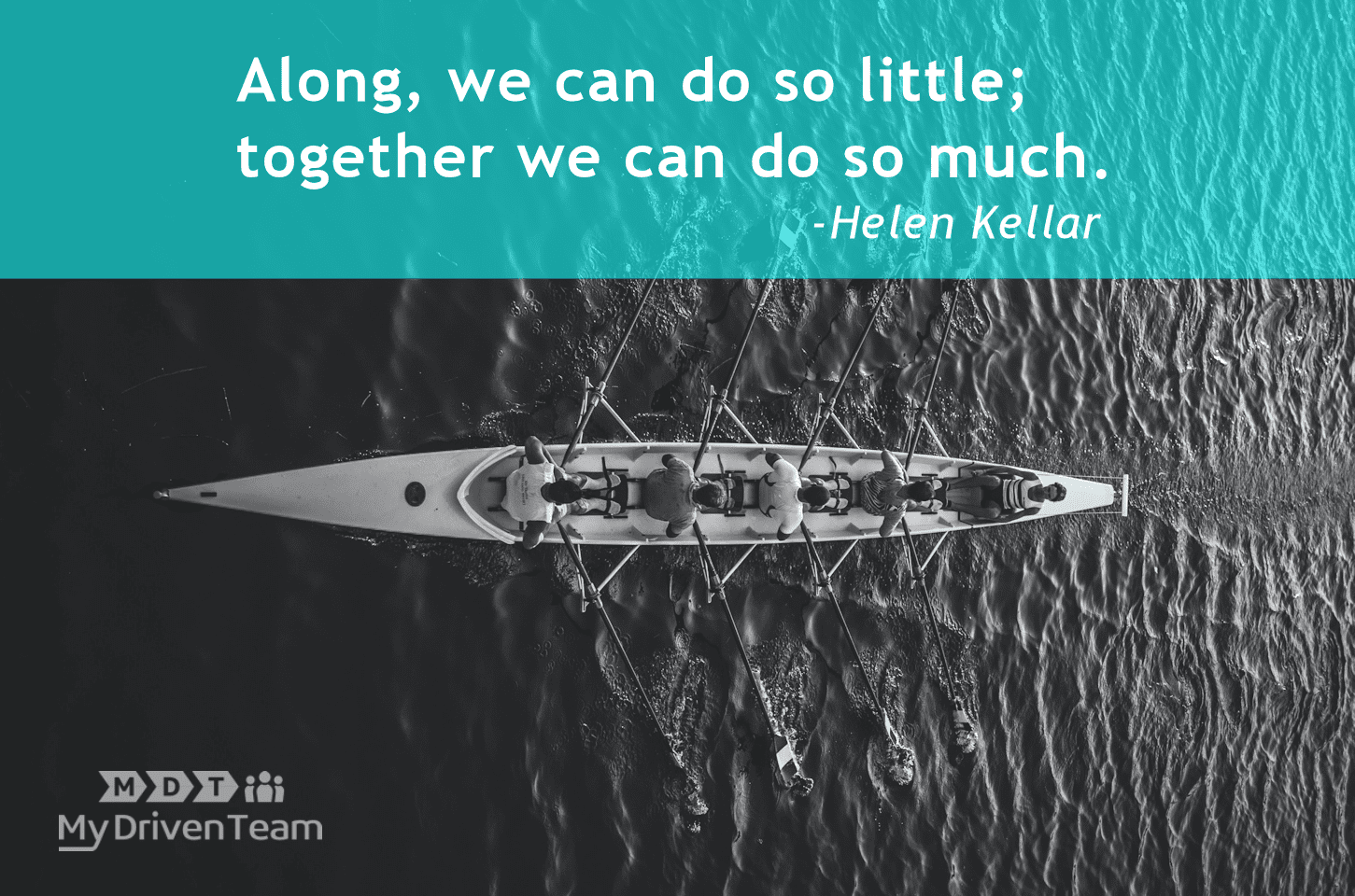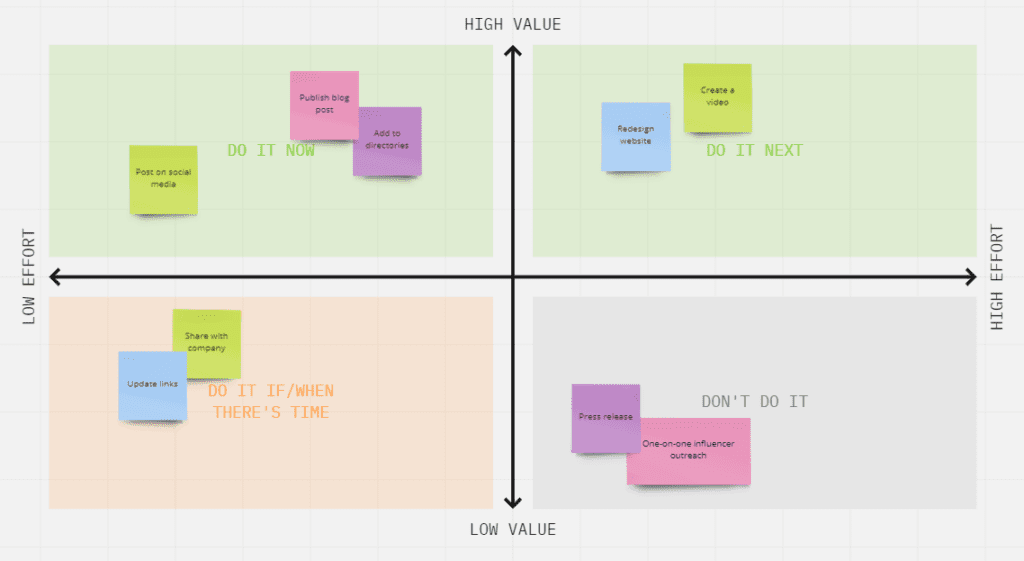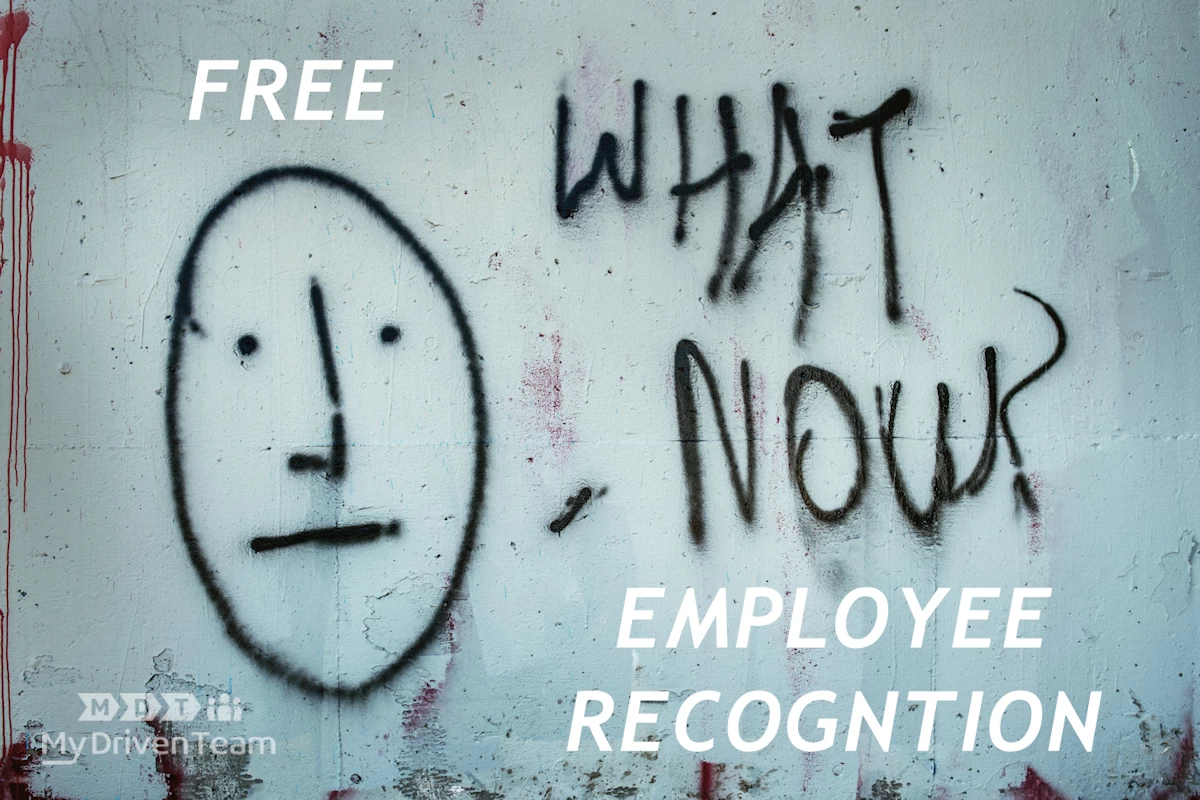
Let’s just start by defining team alignment 9let’s align on alignment). The most applicable of Merriam Webster’s definitions of alignment is: “the state of being joined with others in supporting or opposing something”. You can think of this as a journey where we calibrate everyone’s compass, we give everyone the same map, and we agree on the same destination (and what time we are trying to get there).
There are literally thousands of approaches on team alignment. This unfortunately leaves many leaders left with confusion, frustration, and a status quo approach. If you are one of those leaders, lets turn that around. There’s a better way! Don’t get me wrong, it’s not the easy way. However, the approach I’ll share here is one that asks you to invest in your people while having faith that there will be fruit from those efforts. People don’t come to work to fail!
5 Phases of Team Alignment:
- Set strategic Targets
- Cast The Problem Net
- Build A Plan
- Follow up on the plan with rigor
- Deploy To The Front Lines
Setting Strategic Targets
Why even bother with these? This is actually a good question. Depending on the size of your team, resources at your disposal, and the size of the problems you are trying to solve, it could be a total waste of time. However, if you are serious about getting closer to a particular target, my experience shows that taking the time to set crystal clear goals, will help you get much closer to them…
“The thing about setting targets; when you don’t set one, you hit it every time.”
Luc Morrissette
Long and Short-Term Targets
Typically, I would suggest some big hairy audacious goals (“BHAGs”; Dave Ramsey). The best way is to start by looking out 3-5 years then work your way backwards into a 12 month plan. While the 3-5 isn’t absolutely critical, it’s a great exercise for you and your team. However, the real trick is getting into the details. Saying you will grow by 20% in the next 5 years is a good start. Just go a bit further…do you want to grow revenue or net margin? Is it a straight line improvement or is it a curve?
Do you have any other BHAGs? First step here is to write them down and don’t get too attached, just yet.
This is a really good time to engage with your team. Get their take on the opportunities that exist. Maybe 20% is crazy…maybe it’s way too low? It will be tricky to get them to commit to anything without them starting to throw flags up. That’s when you want to take the next step…
All of these targets should really connect to your overall mission and vision. If you don’t have that….why not? That is a entirely other discussion. I know a lot of organizations skip this step or don’t take it serious, but I’m not sure why? I know personally, I want to know where I’m headed and why.
Casting The Problem Net
I often use a fishing net analogy for this step. We’ve all seen them on TV or maybe even in real life. They cast out this really huge net, drag it for a while, and pull it back in. They don’t know what’s going to be in there, but they hope it will be lot’s of fish! On a good day, it’s a bunch of amazing swordfish! On a bad day it’s mostly trash. On most occasions, it’s a mix of both. So, they gather the swordfish and throw out the old boots.
Problems are the same way. So, you take your target (in this case, let’s say it’s 20% net margin growth, straight line), and you simply ask your team…what stands in our way to hit this target in the next 12 months, 3 years, or 5 years? The bigger the team, the bigger the net. Make sure you write down every tangible problem for two reasons:
- You want them to know you are listening.
- Every problem is an opportunity in hiding.
Once you have your problems listed out, now it’s time to sort them by effort and impact. Start by identifying the biggies. What are those major concerns that really do hold progress back? How much effort will it take to resolve or at least reduce the risk of these issues arising. What about the small stuff…the ones that take a lot of effort and really don’t move the needle. At the end of this exercise, you should end up with four basic categories:
- Do it now
- Do it next
- Do it if / when there’s time
- Don’t do it
Pro-tip…it takes a bit more time, but I find it really helpful to put actual numbers on these (scale). What is high effort? Is it 100 hours or maybe it’s $10,000? What’s high / low impact? Is it zero to $100k or maybe it’s zero to 1,000 new customers? These numbers are often relative to personal perspective, so adding a scale helps with that.

Now, you have those two green blocks above (Do It Now and Do It Next). Great work! The question is, do you, your organization, and team have the resources to attack these? You may not even know what it will take to attack them (which means you might have to ask for help or even do some basic problem solving first).
Either way, this is a crucial part of the “Casting The Problem Net” step. If you have the bandwidth to attack these issues, then it’s time to get serious about your target. Are you going to hold the line at 20%? Maybe after seeing what it will take to get there, you realize 15% has a better ROI. Maybe it’s the opposite and you uncover another opportunity that gets you to 25%. The Japanese call this “catch-ball”. They literally throw the targets back and forth in a game of negotiating that get’s buy-in from all levels. Of course the leaders have the final say, so that the team doesn’t get off too easy (we want their full potential)!!!
Once you are comfortable that the catch-ball process has happened, it’s now time to build a plan!
Building A Plan
This is my personal favorite part of the process! I’m ant ENTJ (Meyers Briggs) if you were wondering. The way I see this is it’s kind of exciting…you get to dream a bit about what it will take to get this done. People often link the writing of the plan with suffering (because they don’t like to write and they don’t want to be held accountable). So, you should find someone on your team that doesn’t mind that (if at all possible). Then just start asking questions for each target your are trying to hit:
- What problem(s) do we need to solve?
- What actions do we need to take to get there?
- Who is going to be responsible for each of those?
- When will they be done by?
- Will the implementation prevent the problem from recurring?
- How will we sustain the change?
Here is a link to a basic format. However, to be clear the format is not what’s important. I’ve driven a lot of change on the back of a napkin (so to speak). The challenge here is commitment!
If the leaders stay committed to reviewing the status of these actions and apply resources (or pressure) when needed, you will see progress!
The last tip I’ll give you is to set up a recurring cadence frequent enough to not let these fade. I like weekly, but it really depends on the size of the issue and team involved. I’d say monthly is a bare minimum.
Following Up On Your Plan With Rigor
While developing a plan can be fun in the right setting, the idea of following up on it can be boring, stressful, and tedious. This is why many teams fall short on this step. However, I do have a few simple suggestions to make it less painful.
- Add a project plan review to your calendar
- Find a list keeper
- Keep the review simple (ask 3 questions everytime)
First, put a project plan review on your calendar and keep it there. If you read much of my stuff, I repeat this over and over again. I’m always shocked when I hear leaders say they are going to do something, but then take little to no action to make sure it happens. Nowadays, it takes less than 5 minutes to setup a repeating calendar invite that will put you on the path to success. Doing this will also make sure the rest of your team knows you mean business.
Next, find someone on your team that likes lists. Maybe that’s you, maybe that’s the janitor…it really doesn’t matter. Their job should be to remind everyone to update their project plans prior to the next review. Having a public way of accessing this is the way to go. I prefer a google sheet or something similar so that everyone can access it at any time. However, I’ve literally used a big piece of paper on the wall as well. Whatever works for you and your team…
Now, for the review itself. Keep it simple. People want to look good (that’s human nature). So, even if something is way off track, they will likely use a mouthful of words to tell you what’s going on. They really just need to answer three questions:
- Is it on track, off track, or complete?
- If it’s off track, when do you anticipate completion and do you need help?
- If it’s complete, is it sustainable (will this process still be in place 6 months from now)?
It’s really the leader’s job to make sure these questions get asked. The good news is, after a few times of doing this, the people will know what to expect. Instead of a mouthful of words and hesitation, they will start to answer these questions without anyone asking them.
Deploy To The Front Lines
This step is easily missed, even with the best of intentions. You’ve done all this great work…you’ve got clear targets, you’ve got a plan, and you have a way to follow through on it. But does the janitor know what’s going on? No, seriously, does he?
Ok, maybe I’m going a bit far with the janitor, but the step of communicating to the front line employees is so important. In my line of work, I’ve been shocked at the insight these people have into the problems that companies face, but I’m also shocked at how disconnected they are to the overall strategy. The more management layers there are, the harder it is.
To make matters worse, this shouldn’t be a one way nor a one time communication. In my experience there are three parts to this process to get it right:
- Purpose
- Status
- Gap Management
Purpose:
Tying purpose to a project or goal doesn’t have to be hard. The easiest way is to say, it will affect your pay by “X” amount. That usually does the trick. However, going further than that is even better. It will affect your pay by “X” and it will help our business grow, which helps people enjoy their lives. However you do it, spend some calories here and it will pay dividends!
Status:
This is usually some kind of metric over a period of time. The idea being that you want people to see clearly if they are winning or not. World class organizations typically use a red or green color to show this. Of course you want to pick a metric that the team has direct control over (at least a heavy influence).
Gap Management:
Wherever there’s a metric, there is a gap. Anytime the metric is red, there is a gap. That means there should be a plan to get back into the green. This one is actually the trickiest of all, because people don’t want to spend time here. It takes a certain level of skill and training to understand the root cause of a problem and to come up with a plan to overcome. My best advice is to start small, but to set expectations that if there is a red, then there should be a plan to get it to green.
Now, last but not least. If you recall earlier I said that this communication should not be one way. That means if the team runs into a problem that they can’t solve on their own, they need a way to get it into the hands of leadership. The more formal you can make this, the better. In my experience, team’s don’t like to show off their problems, so you’ll want a clear process for this so they can trust that leadership wants that information and they won’t get hammered for it.
Conclusion
All of the steps above are shooting for “World Class”. Keep in mind that didn’t happen over-night. Start where you feel most comfortable and work your way out. Clear targets and accountability to a plan are real miracle workers! Of course, simple management by walking around is pretty foundational too. If you have a plan, everyone knows it, and knows when / how the leaders will engage to help them win…you are already off to a great start!



